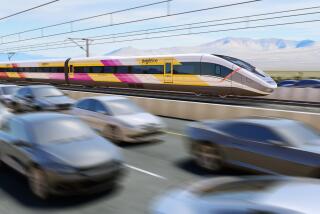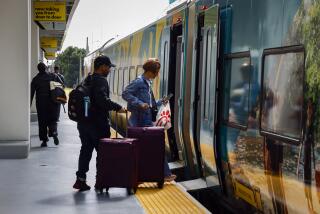China feeling like No. 1 with a bullet train
Reporting from Beijing â Itâs the fastest thing on land with a âMade in Chinaâ label â a bullet train that speeds past unfinished suburbs and broken farmhouses at nearly 200 mph between Beijing and Shanghai in a blur of national pride.
Opened to the public Thursday, the landmark line connects Chinaâs two biggest cities and is meant to showcase the countryâs innovative muscle and give the Chinese Communist Party a shot of legitimacy as it celebrates its 90th birthday.
In a nation obsessed with feats of engineering such as the Three Gorges Dam and the worldâs longest sea bridge (also unveiled Thursday), the national high-speed rail network is something akin to the U.S. space program.
âThis has become a matter of national face,â said Zhou Xiaozheng, a professor of sociology at Peopleâs University in Beijing. âWe love building gigantic projects.â
But it hasnât always been a smooth ride for the $32.5-billion project, which has become a controversial symbol in the countryâs growing divide between rich and poor.
Criticism abounds, mostly online, over the projectâs whopping price tag and the steep cost of tickets. The cheapest fare for the Beijing-Shanghai line is $86, equivalent to one-tenth of an average urbaniteâs monthly salary. And doubts have even been raised over that âMade in Chinaâ label.
But Chinaâs leaders say theyâve opened up a crucial artery that will expand the flow of people and commerce between the countryâs two most important engines â one its political center, the other its commercial heart.
Chinaâs overtaxed transportation system, namely rail, has long been cited as a barrier to economic growth. Although its efficiency can be debated, Beijing has demonstrated time and again that itâs willing to spend massive amounts of money to ensure it has the infrastructure to move the country forward.
The Beijing-Shanghai line is now the crown jewel of a system that already stretches nearly 5,000 miles. The plan is to double the size of the network by 2020, taking riders everywhere from the southern factory hub of Guangzhou to the frosty northern outpost of Harbin to the western frontier city of Urumqi.
The sleek blue-and-white trains known as the Harmony Express take less than five hours to commute from Beijing South Railway Station to Shanghai Hongqiao Railway Station, an 800-mile journey that crosses the same distance as a trip from Los Angeles to Albuquerque but takes more than three times as long on Amtrak.
âI want to know what it feels like to go 300 kilometers [186 miles] an hour,â said Li Zhongxin, 40, who canceled his plans to fly to Shanghai when he learned the high-speed line was opening and bought a $165 one-way rail ticket instead. âMaybe Iâll give up flying altogether.â
Ninety trips in each direction are scheduled daily in a trip so steady that beverages on board barely register a ripple. China Central Television proved the point by standing a cigarette upright on a trainâs window ledge. (Although the most groundbreaking aspect of the train may actually be that itâs all nonsmoking, a huge leap for a country where itâs fine to puff away in a hospital.)
The mega-project was marred by a major corruption scandal in February that led to the dismissal of Railway Minister Liu Zhijun, a powerful apparatchik who boasted of how quickly the system was being built and how little the Chinese were relying on foreign expertise.
Liu was accused in local news reports of taking $125 million in kickbacks that allegedly led to shoddy construction and safety hazards, including on the Beijing-Shanghai corridor.
The controversy was heightened when Zhou Yimin, a former lieutenant of Liuâs, said in media interviews last week that the former chief wanted to push the trains faster than they were capable of going.
Zhou, who has left the Rail Ministry, said the trains owed more to European and Japanese engineering than Chinese, and also worried the project was being constructed dangerously fast.
âMost of the high-speed trains in other countries need three to five years of testing before being operational commercially,â he told the 21st Century Business Herald. âBut what about our [trains]? The project was only 1 to 2 years old, and it already went into mass production.â
Current officials have dismissed the concerns, but skepticism ran high in April when the ministry announced it would reduce the train speeds from as much as 236 mph to cut costs for passengers and increase safety. The reduction meant the trains would run no faster than their Japanese and European counterparts.
While critics joked that China was taking the speed out of high-speed rail, some scholars and economists maintained that the sprawling system would provide immediate benefits to the country.
For one, commerce will flow faster and more freely between nearby cities, especially urban centers in the isolated west. The high-speed trains would also free up space on traditional tracks, providing an additional 50 million tons of badly needed freight capacity each year. Adding more room for passengers is also welcome in a country that seizes up with congestion during its national holidays.
âThis will be a boon for the economy,â said Guo Xiucheng, a transportation expert at Southeast University in Nanjing. âThe volume of capital moving across China will now be greatly improved.â
At the Beijing South station Thursday afternoon, Chinese Premier Wen Jiabao delivered a speech and boarded the first train for Shanghai, the âG1â that left at 3 p.m. Police and media swarmed the cavernous station. A local television team provided a live broadcast from inside the train.
Tao Yu, a computer technician from Shanghai waiting to board the train, was getting into the patriotic spirit.
âIâm very proud because itâs our technology,â said Tao, 37, dragging a suitcase on wheels. âSome say itâs German or Japanese technology, but all these trains look the same. This oneâs ours.â
National duty aside, Tao, a regular commuter between the two cities, said he had a very practical reason for taking the train.
âIâm so scared of flying,â he said. âI hate turbulence. People are meant to be on the ground.â
Nicole Liu and Tommy Yang in The Timesâ Beijing bureau contributed to this report.
More to Read
Sign up for The Wild
Weâll help you find the best places to hike, bike and run, as well as the perfect silent spots for meditation and yoga.
You may occasionally receive promotional content from the Los Angeles Times.







